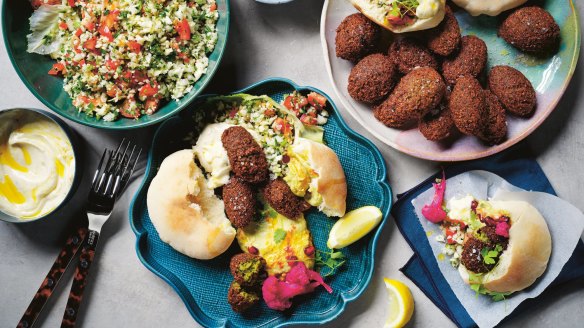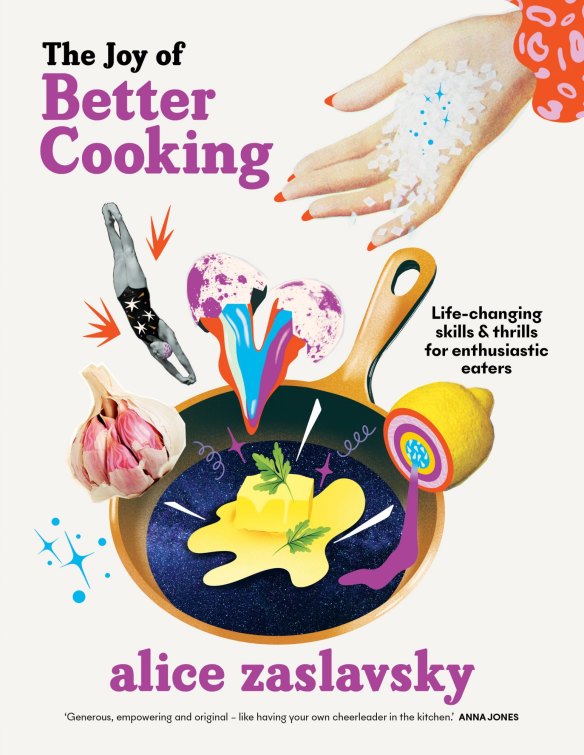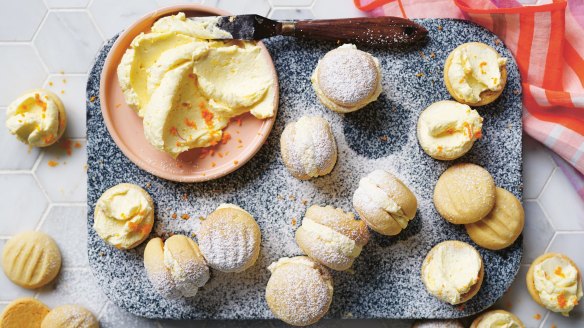Make the kitchen your happy place with Alice Zaslavsky's new cookbook

Finding the joy in cooking comes down to one simple idea, Alice Zaslavsky believes. It's about letting go of the concept of being a "good cook", and all the pressure and hang-ups that come along with it.
Instead, we can aspire to be a better cook, finding our own rhythm and flow in the kitchen.
"Better Cooking is a lifelong journey," she writes in her new cookbook The Joy of Better Cooking.

"It's made up of single steps, with plenty of whoopsies and notes-for-next-time along the way.
"But every step gets you a bit closer to cracking the codes that unlock the confidence to feel freedom and joy in the kitchen."
Here are two recipes to bring joy to your cooking.
Fried green falafels
I learned to make this falafel care of Emi from Egypt, a vivacious woman whose childhood in bustling Cairo could be contained within these fragrant footballs. Emi told me that once I tasted her falafel, I wouldn't want it any other way. I was struck by her confidence, but thought I'd best reserve comment until we'd completed the demo of this very dish. Dear reader, it really is the best falafel recipe, and I'll never make it any other way. Emi uses dried fava beans though, and if you can find them, I'd recommend you sub them in for the chickpeas – but I'm trying to remove every possible excuse in the book, so checkout chickpeas it is!
INGREDIENTS
- oil, for deep-frying (I like grapeseed oil)
- salt flakes, for sprinkling
Falafels
- 2½ cups (500g) dried chickpeas (see Subs), soaked in plenty of cold water overnight (see Shortcuts)
- 2 brown onions, roughly chopped
- 2 tbsp ground coriander
- 2 tbsp ground cumin
- 1½ tbsp garlic powder
- 2 tsp fine salt
- 1½ bunches of parsley, about 150g, roughly chopped (see Tips)
- 1½ bunches of coriander, about 150g, roughly chopped
- 1 tsp bicarbonate of soda (baking soda)
Cauli tabbouleh
- 1 small head of cauliflower, cut into florets, stalk roughly chopped
- ½ salad onion, finely diced
- 2 roma tomatoes, diced
- 1 garlic clove, bruised
- 2 tbsp olive oil
- ½ bunch of parsley, roughly chopped
- ½ bunch of coriander, roughly chopped
Dressing
- 4 tbsp plain yoghurt
- juice of ½ lemon
- 1 tbsp honey
- 1 tbsp tahini
To serve
- soft pita breads
- Hubba-baba ghanoush (see recipe below) or store-bought hummus
- Pickled pink cauli (see recipe below), optional
- lemon wedges
METHOD
- To make the falafels, drain the soaked chickpeas and set aside.
- Place the onion, ground spices, salt and half the parsley and fresh coriander (in that order) in a blender or food processor. Blitz until the onion starts to break down to a sludge, and the herb stalks have yielded to the blades. Add the chickpeas, bicarbonate of soda and the remaining herbs (reserving a handful for garnishing, if you like). Blend to the consistency of a smooth paste.
- Heat the oil in a medium-sized saucepan with high-ish sides; 8-10cm of oil should be plenty.
- Use your tablespoon measure and another tablespoon to scoop and press the mixture into football-looking oblongs. Working in batches, gently drop them into the oil, from as close to the oil as possible, and let them fry for a minute before turning to do the other side. Sometimes they'll stick to the bottom of the pan, but just let them sit there and they'll float up with a little agitation from your spider skimmer or long-handled tongs. Fry for another 2 minutes or so, until each is the colour of leather. Drain each batch on paper towel, sprinkling with salt flakes while still hot for good measure.
- While the falafels are frying, make your tabbouleh. Pop the cauliflower florets in a bowl and cover with freshly boiled water from a kettle. Let them sit for 5 minutes in the water to soften slightly. Combine the salad onion in a bowl with the tomatoes and season with salt and freshly ground black pepper.
- Mix the dressing ingredients together in a jug, ready for pouring.
- Blast your blender with water to dislodge any hop-ons, then pop in the cauliflower florets, garlic clove and olive oil. Blitz until the cauli is finely chopped to the size of couscous.
- Toss the chopped cauli through the tomato mixture. Finish the tabbouleh by stirring through the parsley and coriander just before serving. Drizzle with the yoghurt dressing to finish.
- Serve the falafels in a pita bread, with your hubba-babaghanoush, cauli tabbouleh, pickled pink cauli, if using, and lemon wedges.
- You can store any leftover mixture overnight in the fridge, or even freeze it. You can also fry the balls and freeze for reheating straight from frozen later.
- Depending on what stalk-to-leaf ratio you have in your herbs, this falafel mixture might end up wetter than desired – which you'll be able to tell immediately with the first falafel, as it will frizzle heaps and start to schmutz everywhere. Pop the mixture back into the food processor and blitz in two tablespoons of chickpea flour. The added starch will help bind them right up. And never fear – any schmutz will make a great crumb on poached or soft-boiled eggs, or sprinkled over soups or dips.
- I know you came here for a shorty, but please accept this cautionary tale instead. DO NOT attempt to make the recipe with tinned chickpeas. They are nowhere near starchy enough, and your falafel mixture will quite literally disappear before your very eyes as it fries. There are recipes out there with tinned chickpeas that supplement with flour and other starches, and you're welcome to go hunting … or, just remember to soak your chickies the night before – I promise you it's worth it!
- As an alternative to chickpeas, try using dried lima beans or fava beans. Texturally, it doesn't hurt to pop these legumes out of their skins. Once soaked for long enough, the skins should slip right off.
Makes about 30

Hubba-baba ghanoush
You know those ads for tacos where the little girl says, "Why not have both?" Well I am that girl, asking, if you're deciding between making hummus or baba ghanoush, why NOT have both? In this mash-up of the two, the chickpeas help make the baba even smoother and creamier, while the eggplant makes the hummus infinitely more interesting. And the pickled cauliflower florets just cap it all off – like chewed-up bits of purple Hubba Bubba bubble gum. On toast with avocado, as a "puree" with Middle Eastern mains, or straight from the fridge, this dip is just hubba-hubba.
INGREDIENTS
- 1¼ cups (250g) dried chickpeas, soaked overnight (see Shortcuts)
- 2 strips dried kombu (optional, but good if you're gassy)
- 2-3 medium-large eggplants, the glossier the better
- 1 massive handful of parsley, roughly chopped
- 1 massive handful of coriander, roughly chopped
- 4 garlic cloves, peeled
- juice of 2 lemons
- 3 tbsp extra virgin olive oil, plus extra to serve
- 2 tbsp tahini (see Subs)
- 1 tbsp salt flakes
- 1 tsp ground coriander
- ½ tsp ground cumin
- ¼ tsp sweet smoked paprika, plus extra to serve
- 1-2 ice cubes (see Tips)
- 1 cauliflower, washed, dried and cut into florets (see Tips)
- 1 medium beetroot, peeled and roughly chopped
- ½ tbsp caraway seeds (optional, but excellent)
- 2 bay leaves
- 1 cup (250ml) white wine vinegar or apple cider vinegar
- 4-5 garlic cloves, peeled and bruised
- 3 tbsp salt flakes
- 1 tsp caster sugar
To serve
- parsley, roughly chopped
- coriander, roughly chopped
- pomegranate seeds
- Falafels (see recipe above)
- soft pita breads
METHOD
- Drain the soaked chickpeas and place in a large saucepan with 12 cups (3 litres) cold water and the kombu, if using – but no salt! Bring to the boil, then simmer for about 1½ hours. Once the chickpeas are soft enough to squash between your fingers, drain and allow to cool slightly, removing the kombu. At this point I like to peel the chickpeas for the smoothest hummus, but you are SO welcome to skip this step. I'm already asking a lot.
- While the chickpeas are simmering, roast the eggplants over a gas cooktop (see Tips) or barbecue over medium heat, rotating occasionally, for 30-45 minutes, until blackened on all sides and completely soft in the middle. Alternatively, pop the eggplants on a rack over a baking tray and roast in a 200C fan-forced (220C conventional) oven for an hour or so, until the skin has charred, and when poked seems more balloon than eggplant. Leave until cool enough to handle, draped over a clean sink to leak out a whole lot of schmutz that will otherwise make your baba way too watery.
- For the pickled cauli, bring a large-ish saucepan of well-salted (preferably filtered) water to the boil. Add the cauliflower florets and beetroot and bubble away for 3 minutes to soften slightly. Drain, reserving 3 cups (750ml) of the now magenta-coloured water. Divide the veg among two sterilised containers each about 300ml in capacity. Sprinkle the caraway seeds evenly on top, finishing with a bay leaf.
- Pour the reserved poaching water back into the pan. Add the vinegar, garlic, salt and sugar and bring to the boil. Pour this mixture over the veg to cover and seal. If there isn't enough liquid, boil a little more vinegar and pour over the top. The cauli and beet will get even better after a day of hanging out in the pickling liquid, and will last comfortably for up to a month in the fridge.
- Scoop the eggplant flesh into a food processor. Toss in the chickpeas and remaining ingredients (including the ice cubes) and blitz until smooth and velvety, adding more olive oil if you want it even creamier. Taste for seasoning.
- Serve warm or cold, topped with the pickles, extra herbs and pomegranate seeds, with falafels and soft pita breads to round it all out. The hubba will last for up to a week in the fridge in an airtight container – just cover with olive oil to help stop a skin forming, and give it a good stir before serving, if need be.
Serves 4-6 as a dippy starter, or as part of a main meal
- To speed up the chickpea-soaking process, pop them in a big saucepan and pour in enough cold water to cover them by a good inch or so. Bring to the boil, reduce the heat and simmer for 5 minutes, then turn off the heat. Leave to soak in this water for 1 hour, then drain and cook as per the instructions; they'll cook in around half the time!
- A pressure cooker is another option, if you have one – once it comes up to pressure, 15 minutes is enough time to cook the chickpeas, once soaked.
- In even more of a hubba-hurry? Go the tinned route, of course, but please do rinse them – keeping the aquafaba if you like – and consider popping the chickpeas out of their skins for the smoothest finish.
- If you're out of tahini, you can use sesame oil instead
- The ice cubes help the hummus become extra fluffy – a very cool trick I learned from Noor Murad at Ottolenghi Test Kitchen. If you're worried your food processor or blender can't handle it, skip this step.
- If using a gas cooktop to char the eggplants, use some foil as a splatter guard. Take the trivet off your chosen burner. Poke a hole in a sheet of foil, so it will skirt around the heat source, and place it over the top, to cover the rest of your cooktop. This will catch the eggplant weepings and make for easier clean-up.
- If you're roasting the eggplant in the oven, to save on energy, bake something else in there too – like, say, a halved butternut pumpkin, or some veg.
- To cut the cauli into florets, place upside-down on a chopping board, and hold onto the stalk end while you twist or snip away at the florets from the base. Cut the florets in half again so that they're all roughly the same fork-friendly size.

Lady Marmalade melting moments
You know that version of the song Lady Marmalade, where Christina Aguilera pumps out that EPIC note as she begins her verse? What a MOMENT, right!? That's what these melting moments remind me of. The slightly bitter tang of the marmalade in the buttercream is enough to splice through the richness of the biscuit and filling, and as it melts on your tongue, you'll find yourself having a moment, too. I've adopted the custard powder of the classically Aussie yo-yo biscuit, because I like the colour and flavour it provides. Most melting moments recipes use cornflour – either of these additions stop the flour and fat binding too tightly, which means the biscuit will, quite literally, melt in your mouth.
INGREDIENTS
- ⅓ cup (40g) icing sugar
- 250g unsalted butter, softened
- 1½ cups (225g) plain flour, plus extra for dusting (see Subs)
- ½ cup (75g) custard powder (see Subs)
- 1 tsp baking powder
- ¼ tsp salt flakes
Marmalade buttercream
- 100g unsalted butter, softened
- ⅔ cup (85g) icing sugar, plus extra for dusting
- zest and juice of ½ orange
- 1 heaped tbsp orange marmalade
METHOD
- Line two light-coloured (see Tips) baking trays (ideally biscuit trays) with baking paper.
- If your icing sugar is lumpy, pop it into a food processor and blitz, or into a zip-lock bag and mash with a rolling pin.
- Using a stand mixer with the paddle attachment, beat the softened butter until uniformly soft, then add the icing sugar and beat until the mixture is pale and creamy (more is more here).
- Sift together the flour, custard powder and baking powder. Add to the butter mixture, along with the salt, and mix with a wooden spoon until just combined.
- Use a teaspoon measure dusted with a smidge of flour to scoop out 2 level teaspoons (5g) of the mixture, rolling into walnut-sized balls between your hands. If your hands are hot, pat a little flour onto them to stop the mixture sticking. Evenly space the balls out on the baking trays. Don't worry if they're a bit mangy; you can always smooth them out once chilled.
- Pop the trays in the fridge to chill for 15 minutes, or even overnight.
- When ready to bake, preheat the oven to 150C fan-forced (170 conventional). Use a floured fork to press each dough ball into a 2cm disc. Bake for 15-18 minutes, until the biscuits are set enough to be dislodged with a gentle prod, are custard-yellow in colour and the bottom is still blonde. Allow to cool for 10 minutes, then cool completely on a wire rack before filling.
- Make your buttercream in the stand mixer by creaming the butter and icing sugar together until super pale. Add the orange zest, juice and marmalade and beat until incorporated.
- To fill the biscuits, either transfer the buttercream to a piping bag and squeeze it over half the biscuits, or spread a teaspoon of filling over them. Pop the unfilled biscuits on top of the filled ones like hats, squashing ever so slightly to more evenly distribute the filling.
- Give the whole lot one last dusting of icing sugar as a final flourish.
- The biscuits will keep in an airtight container in a cool place for up to 5 days. They can also be frozen (filled or unfilled) for up to 3 months; thaw for at least 30 minutes before serving.
Makes about 25 filled sandwiched biscuits
- Place any leftover dough on a piece of baking paper, roll up into a log (twisting the edges so it looks like salami) and stash in the freezer. When you have a hankering, simply slice off 1cm pieces and bake as normal.
- There are entire books and blogs dedicated to tweaking the various variables on the biscuit/cookie caper, but some tricks of the trade are so tried and true that you simply must capitulate – after all, it's science!
- For evenly coloured biscuits, using an aluminium or lighter-coloured biscuit tray will make all the difference – the darker the tray, the more heat it absorbs, which leads to toasty bottoms (not in a good way, sadly). Biscuit trays are also almost entirely flat, which means that the heat can access each side of the biscuit evenly.
- The more butter/fat you add to the dough, the "shorter" your biscuit will be, meaning the more easily it crumbles.
- You can use cornflour if you don't have custard powder; if so, add 1 teaspoon vanilla extract or vanilla bean paste PLUS an extra 1 tablespoon icing sugar to your biscuit mixture.
- Amazingly, gluten-free flour is just as good here!
This is an edited extract from The Joy of Better Cooking by Alice Zaslavsky, photography by Ben Dearnley. Murdoch Books, RRP $49.99. Buy now